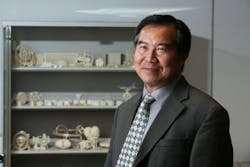Missouri S&T, Honeywell partner for metal additive manufacturing research
From hip and knee joints to complex fuel injectors, metal additive manufacturing, which involves lasers and powder-based metals, can produce components that traditional machining processes cannot match in time-to-part, geometric complexity, and manufacturing cost.
A team of Missouri University of Science and Technology (Missouri S&T; Rolla, MO) researchers is collaborating with Honeywell Federal Manufacturing & Technologies (Kansas City, MO) on a five-year project to perform material analysis for the selective laser melting (SLM) process in metal powder bed. Dr. Ming Leu, Keith and Pat Bailey Missouri Distinguished Professor of Integrated Product Manufacturing and the director of the Intelligent Systems Center at Missouri S&T, is leading a team of seven other Missouri S&T professors on the project.
To make a part, a focused laser beam follows a predetermined trajectory to quickly melt metal particles in the powder bed and solidify the molten metal into the desired shape, layer by layer, based on a computer-aided design (CAD) model. Internal features of great complexity, from honeycombs to holes through a twisted part, are possible with this manufacturing method.
With equipment Honeywell purchased and installed in Toomey Hall for the project, Leu and colleagues have four research objectives: to predict the properties of the built parts, control microstructures to achieve desired properties, maximize powder reuse, and increase product sustainability.
The five-year project is funded with about $5 million for personnel and other expenses, and about $1.5 million for the equipment Honeywell purchased, loaned to, and placed at Missouri S&T. The project consists of five tasks: powder characterization, material property characterization methods, temperature effects on material properties, controlling microstructure and mechanical properties, and chemistry specifically for additive manufacturing. Stainless steel 304L is used initially as the build material.
“We look at how process parameters affect the mechanical properties of the manufactured part and how to control those parameters to achieve desired properties,” Leu says. “The laser’s power, the beam diameter, the traverse speed, the line spacing, and the layer thickness all can affect the parts produced.” Chemical composition and environment temperature are other factors that can significantly affect the part’s properties, he says.
The team is also investigating ways to reuse powder to reduce the cost of raw materials. A problem with this, Leu says, is that because of heat effect, the powder immediately surrounding the part made may have degraded or clumped to be used again to make parts as good as those from virgin materials. Reduced strength is an example of how the reused powder might negatively affect the finished product.
Working with Leu are: Dr. Doug Bristow, associate professor of mechanical and aerospace engineering; Dr. Lianyi Chen, assistant professor of mechanical and aerospace engineering; Dr. Ed Kinzel, assistant professor of mechanical and aerospace engineering; Dr. Robert Landers, professor of mechanical and aerospace engineering and associate chair for graduate affairs; Dr. Frank Liou, Michael and Joyce Bytnar Product Innovation and Creativity Professor and director of the manufacturing engineering program; Dr. Ronald J. O’Malley, the F. Kenneth Iverson Endowed Chair of Steelmaking Technologies and director of the Kent D. Peaslee Steel Manufacturing Research Center; and Dr. Joseph Newkirk, associate professor of metallurgical engineering. The project also includes a total of about 15 graduate and undergraduate students and post-doctoral fellows.
For more information, please visit www.mst.edu.

